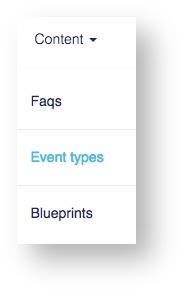Event types are where you define the forms that you will ask your users to complete. They allow you to create all your own fields and build in a workflow so that it can be passed through multiple users of the system before it is considered complete.
...
- Navigate to Content → Event types from the top toolbar. If you don't see this option please talk to your organisation administrator around which permissions you have assigned to you.
- The following list displays all event types contained with the system. These are ordered into three sections: draft (orange), published (green), archived (red). Within each section the event types are ordered alphabetically.
- Draft = event types currently being built which are not yet visible to users of the system.
- Published = event types that can be created and submitted onto timelines by users of the system.
- Archived = event types that were previously published. Users can no longer add new events of this type but all historical entries are preserved.
- At the top of the list select the button New event type which will take you to the event properties screen.
- The event properties screen will ask you to input some basic information about the event type you are creating:
- Event type name = this is what all users of the system will see when selecting from the list of event types. It is also the name that will appear on timelines.
- Event type identifying colour = all events added onto timelines will have a circular colour indicator next to them. This can be useful to help visually distinguish between different categories of event.
- Add tags to this event = allows you to preselect from your defined blueprints. This will automatically apply any tags you select here to the event whenever a user adds this to their timeline.
- This event can be owned by = select from the list of roles that you have created in the system. This determines which users' timelines this event can be added onto.
- Specify default visibility:
- Public = this event will be visible to the owner and any other users who have permissions to view their timeline
- Private = the completed event will only be visible to the owner
- Owner can change visibility on individual events = this allows the owner to change the visibility of these published events, or limit them only to the default setting above.
- Specify default view for completed events = this is a setting that is currently under development and can be ignored at this time.
- The lower section is where you define the workflow of the event using form sections, click Add new section to add a new one. The event moves through the workflow from top to bottom to different users of the system depending on which roles you set to be responsible for each one. .
- Click Save at the top of the event properties screen to save this as an event type in draft status.
...
| Info |
|---|
The Timeline owner role is used to specify the individual who owns this event rather than one of a group of people belonging to a role. |
Related articles
| Filter by label (Content by label) | ||||||||||||||||||
|---|---|---|---|---|---|---|---|---|---|---|---|---|---|---|---|---|---|---|
|
...


